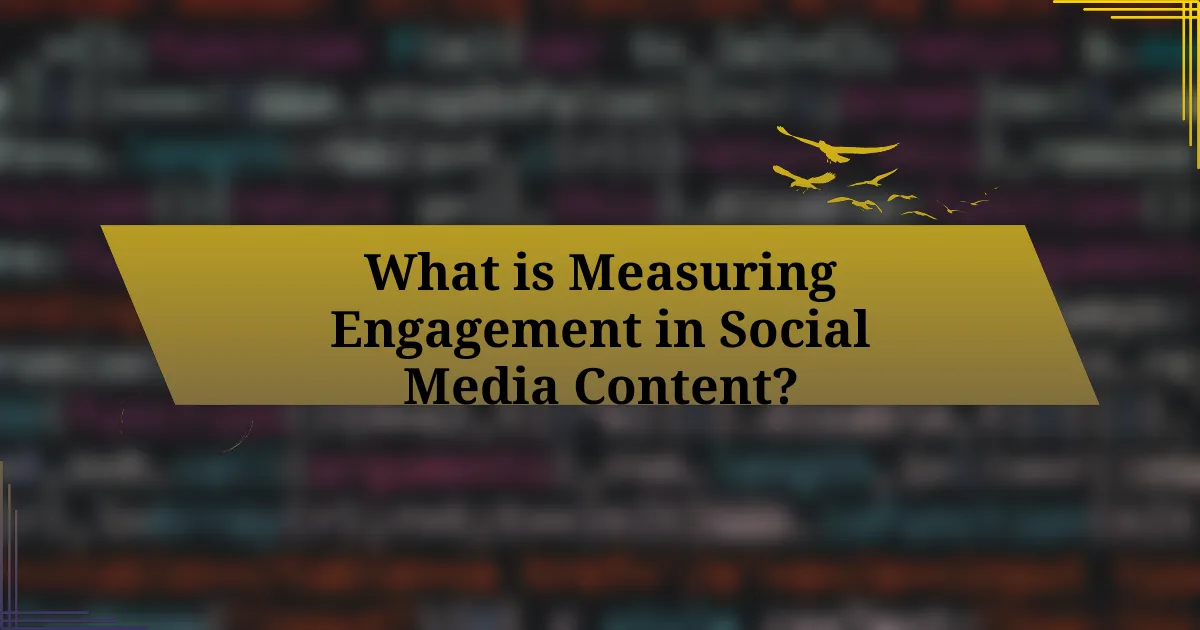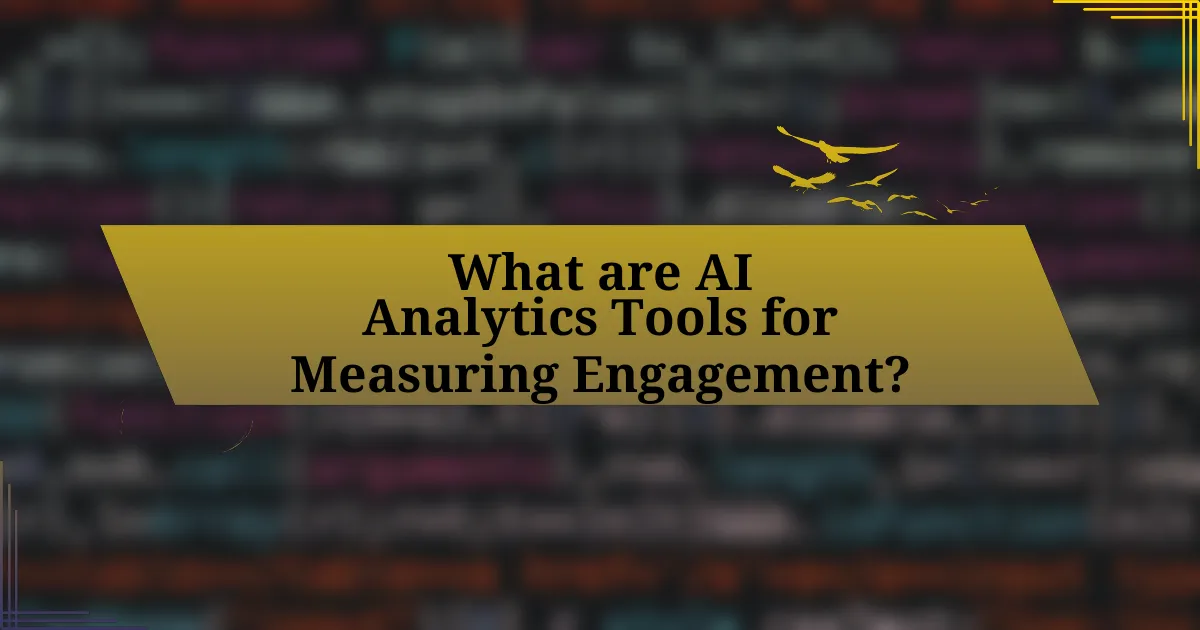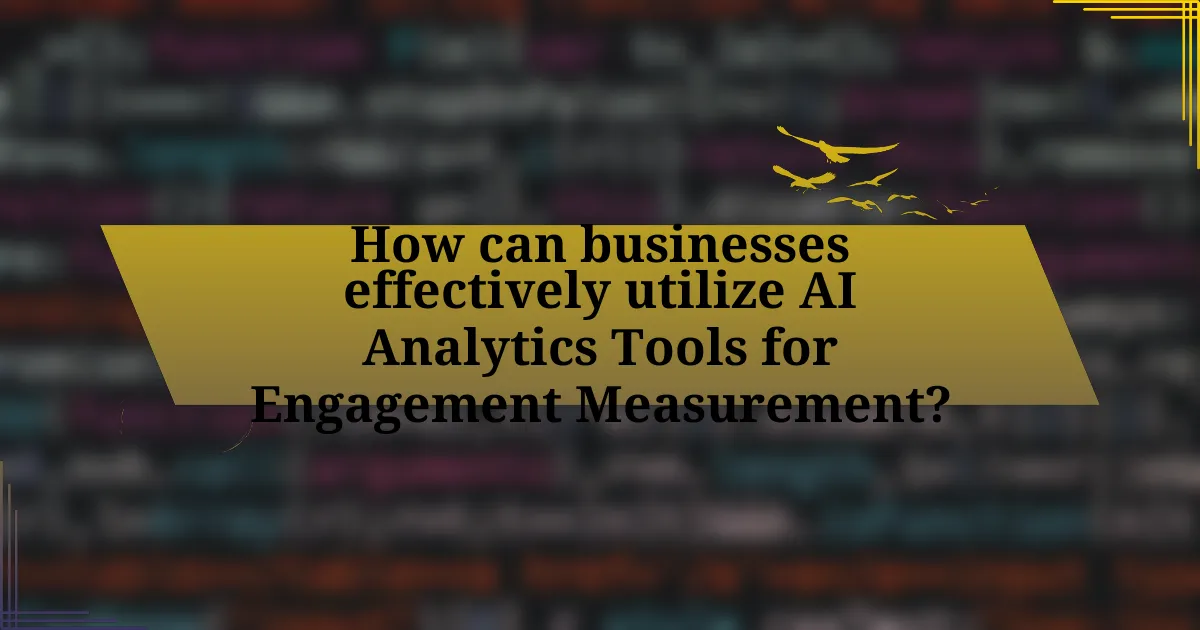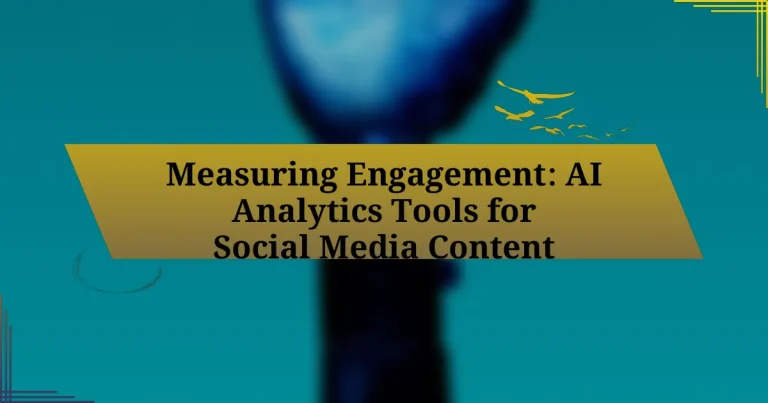Measuring engagement in social media content is the process of quantifying user interactions, such as likes, shares, comments, and overall reach, to assess how effectively content resonates with audiences. This article explores the definition of engagement, common metrics used for measurement, and the varying definitions across different social media platforms. It highlights the importance of engagement for social media strategies, its impact on brand visibility and audience loyalty, and the role of AI analytics tools in enhancing engagement measurement. Additionally, the article discusses best practices for utilizing these tools, overcoming challenges, and continuously improving engagement strategies.

What is Measuring Engagement in Social Media Content?
Measuring engagement in social media content refers to the process of quantifying interactions between users and content, such as likes, shares, comments, and overall reach. This metric is crucial for understanding how effectively content resonates with an audience and drives user participation. According to a report by Sprout Social, posts with higher engagement rates are more likely to be seen by a larger audience due to social media algorithms favoring popular content.
How is engagement defined in the context of social media?
Engagement in the context of social media is defined as the interaction between users and content, which includes actions such as likes, shares, comments, and follows. This interaction is crucial as it reflects the audience’s interest and involvement with the content, indicating its effectiveness. According to a report by Sprout Social, posts with higher engagement rates are more likely to be seen by a larger audience due to social media algorithms favoring content that generates interaction.
What metrics are commonly used to measure engagement?
Common metrics used to measure engagement include likes, shares, comments, click-through rates, and time spent on content. These metrics provide insights into how audiences interact with social media content, indicating levels of interest and involvement. For instance, likes and shares reflect immediate reactions and the willingness to promote content, while comments offer qualitative feedback and deeper engagement. Click-through rates measure the effectiveness of calls to action, and time spent on content indicates how compelling the material is to the audience. Collectively, these metrics help assess the overall effectiveness of social media strategies and content performance.
How do different platforms define engagement differently?
Different platforms define engagement based on their unique user interactions and metrics. For instance, Facebook measures engagement through likes, shares, comments, and post clicks, emphasizing social interactions and content sharing. In contrast, Instagram focuses on likes, comments, and story views, highlighting visual content interaction. Twitter defines engagement primarily through retweets, likes, and replies, reflecting real-time conversations. LinkedIn measures engagement through post interactions, shares, and profile views, targeting professional networking. Each platform’s definition aligns with its user base and content type, demonstrating the variability in engagement metrics across social media.
Why is measuring engagement important for social media strategies?
Measuring engagement is crucial for social media strategies because it directly reflects how well content resonates with the audience. High engagement rates indicate that users are interacting with posts, which can lead to increased brand awareness and loyalty. According to a study by HubSpot, brands that actively measure engagement see a 30% higher return on investment in their social media efforts. This data underscores the importance of tracking metrics such as likes, shares, comments, and click-through rates to refine content strategies and optimize audience targeting.
What impact does engagement have on brand visibility?
Engagement significantly enhances brand visibility by increasing the likelihood of content being shared and seen by a broader audience. When users interact with a brand’s content through likes, comments, or shares, it triggers algorithms on social media platforms to promote that content more widely, resulting in greater exposure. For instance, a study by Hootsuite found that posts with higher engagement rates can reach up to 50% more users than those with lower engagement, demonstrating a direct correlation between engagement levels and visibility.
How does engagement influence audience loyalty?
Engagement significantly influences audience loyalty by fostering a deeper emotional connection between the audience and the content. When audiences actively interact with content—through likes, shares, comments, or participation in discussions—they feel valued and recognized, which enhances their commitment to the brand or creator. Research indicates that brands with high engagement rates see a 20% increase in customer loyalty, as engaged audiences are more likely to return and advocate for the brand. This correlation is supported by a study from Gallup, which found that emotionally engaged customers are 23% more likely to purchase and remain loyal to a brand.

What are AI Analytics Tools for Measuring Engagement?
AI analytics tools for measuring engagement are software solutions that utilize artificial intelligence to analyze user interactions and behaviors on social media platforms. These tools provide insights into metrics such as likes, shares, comments, and overall audience sentiment, enabling businesses to assess the effectiveness of their content strategies. For instance, tools like Sprout Social and Hootsuite leverage AI algorithms to track engagement patterns and generate reports that help marketers optimize their campaigns. According to a report by Gartner, organizations using AI-driven analytics can improve their decision-making processes by up to 30%, highlighting the value of these tools in enhancing engagement measurement.
How do AI analytics tools function in social media?
AI analytics tools function in social media by utilizing algorithms to analyze user data, engagement metrics, and content performance. These tools collect vast amounts of data from social media platforms, including likes, shares, comments, and follower demographics, to identify trends and patterns in user behavior. For instance, a study by Sprout Social found that brands using AI analytics can increase engagement rates by up to 30% by tailoring content based on insights derived from user interactions. This data-driven approach enables marketers to optimize their strategies, enhance audience targeting, and improve overall content effectiveness.
What technologies underpin AI analytics tools?
AI analytics tools are underpinned by several key technologies, including machine learning, natural language processing, big data analytics, and cloud computing. Machine learning algorithms enable these tools to identify patterns and make predictions based on historical data, while natural language processing allows for the analysis of text data from social media interactions. Big data analytics provides the capability to process and analyze vast amounts of data in real-time, and cloud computing facilitates scalable storage and processing power. These technologies collectively enhance the ability of AI analytics tools to measure engagement effectively on social media platforms.
How do these tools collect and analyze data?
AI analytics tools for social media content collect and analyze data through various methods, including automated data scraping, user interaction tracking, and sentiment analysis. These tools utilize algorithms to gather data from social media platforms, capturing metrics such as likes, shares, comments, and user demographics. For instance, tools like Hootsuite and Sprout Social employ APIs to access platform data, allowing for real-time analysis of engagement metrics. Additionally, machine learning techniques are applied to interpret user sentiment from comments and posts, providing insights into audience perceptions. This combination of data collection methods and analytical techniques enables businesses to understand engagement levels and optimize their social media strategies effectively.
What types of AI analytics tools are available for social media?
AI analytics tools for social media include sentiment analysis tools, engagement metrics analyzers, audience insights platforms, and content performance trackers. Sentiment analysis tools, such as Brandwatch and Lexalytics, assess public sentiment towards brands or topics by analyzing social media conversations. Engagement metrics analyzers, like Sprout Social and Hootsuite, measure likes, shares, comments, and overall interaction rates to evaluate content effectiveness. Audience insights platforms, such as Facebook Insights and Twitter Analytics, provide demographic and behavioral data about followers, helping brands tailor their strategies. Content performance trackers, including BuzzSumo and Google Analytics, analyze how specific posts perform over time, offering insights into what resonates with audiences. These tools collectively enhance social media strategies by providing data-driven insights.
Which tools are best for tracking engagement metrics?
The best tools for tracking engagement metrics include Google Analytics, Hootsuite, Sprout Social, and Buffer. Google Analytics provides comprehensive insights into website engagement, including user behavior and traffic sources. Hootsuite offers social media management features that allow users to monitor engagement across multiple platforms in real-time. Sprout Social provides detailed analytics and reporting on social media interactions, helping brands understand audience engagement. Buffer simplifies social media scheduling while offering analytics to track post performance and audience engagement. These tools are widely recognized for their effectiveness in measuring engagement metrics across various digital platforms.
How do different tools compare in terms of features and usability?
Different AI analytics tools for social media content vary significantly in features and usability. For instance, tools like Hootsuite and Sprout Social offer comprehensive dashboards that integrate multiple social media platforms, allowing users to manage posts, track engagement metrics, and analyze audience demographics seamlessly. In contrast, simpler tools like Buffer focus primarily on scheduling posts, which may limit their analytical capabilities but enhance usability for users seeking straightforward functionality.
Usability is often assessed through user interface design and ease of navigation; for example, Sprout Social is frequently praised for its intuitive layout, while more complex tools like Google Analytics may require a steeper learning curve due to their extensive feature set. According to a 2022 survey by Social Media Examiner, 70% of marketers prefer tools that provide user-friendly interfaces over those with more advanced features but complicated navigation. This highlights the importance of balancing feature richness with usability in selecting the right analytics tool for measuring engagement on social media.

How can businesses effectively utilize AI Analytics Tools for Engagement Measurement?
Businesses can effectively utilize AI analytics tools for engagement measurement by leveraging data-driven insights to analyze user interactions and optimize content strategies. These tools can track metrics such as likes, shares, comments, and click-through rates in real-time, allowing businesses to identify which content resonates most with their audience. For instance, a study by McKinsey found that companies using advanced analytics can improve their marketing ROI by 15-20%. By employing AI algorithms, businesses can segment their audience based on behavior and preferences, enabling personalized content delivery that enhances engagement. Additionally, predictive analytics can forecast future engagement trends, helping businesses to proactively adjust their strategies for maximum impact.
What strategies should businesses adopt when using these tools?
Businesses should adopt a data-driven approach when using AI analytics tools for social media content. This involves regularly analyzing engagement metrics such as likes, shares, comments, and click-through rates to understand audience preferences and behaviors. By leveraging these insights, businesses can tailor their content strategies to enhance user engagement and optimize their social media presence. For instance, a study by Hootsuite found that brands that utilize analytics to inform their content strategy see a 30% increase in engagement rates compared to those that do not.
How can businesses set measurable goals for engagement?
Businesses can set measurable goals for engagement by defining specific, quantifiable metrics that align with their overall objectives. For instance, they can establish targets such as increasing social media interactions by 20% over the next quarter or achieving a 15% growth in email open rates within six months. These metrics should be tracked using analytics tools that provide data on user behavior, such as likes, shares, comments, and click-through rates. By utilizing AI analytics tools, businesses can gain insights into audience preferences and engagement patterns, allowing them to adjust their strategies accordingly. This approach ensures that goals are not only measurable but also relevant to the business’s engagement strategy.
What role does data interpretation play in strategy adjustment?
Data interpretation is crucial for strategy adjustment as it enables organizations to analyze performance metrics and derive actionable insights. By examining data trends, companies can identify what content resonates with their audience, allowing them to refine their social media strategies effectively. For instance, a study by the Content Marketing Institute found that 70% of marketers who analyze data regularly report improved engagement rates. This demonstrates that informed adjustments based on data interpretation lead to enhanced audience interaction and overall strategy effectiveness.
What are common challenges faced when measuring engagement?
Common challenges faced when measuring engagement include data inconsistency, varying metrics across platforms, and the difficulty in attributing engagement to specific content. Data inconsistency arises when different tools or platforms report engagement metrics differently, leading to confusion. Varying metrics across platforms complicate comparisons, as each social media site may define and measure engagement differently, such as likes, shares, or comments. Additionally, attributing engagement to specific content can be challenging due to the influence of external factors, such as timing and audience demographics, which can skew results and make it hard to determine what drives engagement effectively.
How can businesses overcome data privacy concerns?
Businesses can overcome data privacy concerns by implementing robust data protection measures and ensuring transparency in data handling practices. This includes adopting encryption technologies to secure sensitive information, conducting regular audits to identify vulnerabilities, and complying with regulations such as the General Data Protection Regulation (GDPR), which mandates strict guidelines for data collection and processing. According to a 2021 report by the International Association of Privacy Professionals, organizations that prioritize data privacy not only mitigate risks but also enhance customer trust, leading to improved engagement and loyalty.
What steps can be taken to ensure data accuracy?
To ensure data accuracy, organizations should implement data validation techniques, conduct regular audits, and utilize automated data entry systems. Data validation techniques, such as checks for data type consistency and range limits, help identify errors at the point of entry. Regular audits, which involve cross-referencing data against reliable sources, can uncover discrepancies and ensure ongoing accuracy. Automated data entry systems reduce human error by minimizing manual input, thereby enhancing the reliability of the data collected. According to a study by IBM, poor data quality costs organizations an average of $13 million annually, highlighting the importance of these steps in maintaining data integrity.
What best practices should be followed for maximizing engagement measurement?
To maximize engagement measurement, organizations should implement a multi-faceted approach that includes defining clear engagement metrics, utilizing advanced analytics tools, and regularly analyzing data for actionable insights. Defining metrics such as likes, shares, comments, and click-through rates provides a concrete framework for measurement. Advanced analytics tools, like AI-driven platforms, can process large datasets to identify trends and patterns in user behavior, enhancing the understanding of what drives engagement. Regular analysis of this data allows organizations to adapt their strategies in real-time, ensuring that content remains relevant and engaging. For instance, a study by HubSpot found that companies using data-driven strategies to measure engagement saw a 30% increase in their overall engagement rates.
How can businesses continuously improve their engagement strategies?
Businesses can continuously improve their engagement strategies by leveraging AI analytics tools to gather and analyze data on audience interactions. These tools provide insights into user behavior, preferences, and trends, enabling businesses to tailor their content and communication effectively. For instance, a study by McKinsey found that companies using advanced analytics can improve their marketing ROI by 15-20%. By regularly assessing engagement metrics such as likes, shares, and comments, businesses can identify what resonates with their audience and adjust their strategies accordingly. This data-driven approach fosters ongoing optimization and enhances overall engagement.
What tools can assist in refining social media content based on engagement data?
Tools that can assist in refining social media content based on engagement data include Hootsuite, Sprout Social, and Buffer. Hootsuite provides analytics that track engagement metrics such as likes, shares, and comments, allowing users to adjust their content strategy accordingly. Sprout Social offers detailed reports on audience engagement and content performance, enabling users to identify trends and optimize future posts. Buffer also analyzes engagement data to suggest the best times to post and the types of content that resonate most with the audience. These tools are widely recognized for their effectiveness in enhancing social media strategies through data-driven insights.

